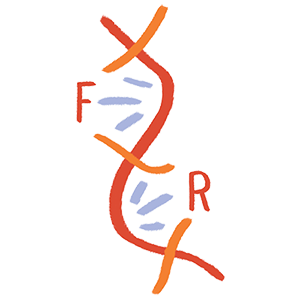
A shelf of boxes for sale labeled “BABY” with the text “No Defects – Guaranteed” at the bottom. Some of the boxes are a light pink, some of them baby blue, each with an image of a baby’s face with fair skin and either a tuft of blonde or dark brown hair. On the shelf there is a barcode and a yellow “Best Seller” tag hanging off the price sticker. Artwork by Clare Kim .
Are designer babies the future of genetic modification technology? Some of the ways we use this technology can save countless lives by eliminating cancer and disease – but at what cost?
Genetic technology has become increasingly powerful and precise. CRISPR (CRISPR-Cas9), a gene modification technique harnessed in 2013, is capable of editing human embryo genomes more successfully and more rapidly than previous methods by being able to splice genomes in cells at specific sites. By splicing and altering DNA at chosen sites, scientists can modify which genes are expressed in people, ranging from physical characteristics to genetic disorders. While there is still much research to be done before the technology is used on humans, scientists are optimistic about its potential to put an end to certain genetic diseases (such as sickle cell anemia and muscular dystrophy) and revolutionize treatment. These treatments primarily involve somatic cells, or cells in a living organism that are not reproductive. On the other hand, genetic modification of germline cells, which are reproductive cells that can pass DNA down to following generations, raise a whole new set of questions. With this blooming technology, we can foresee a future in which parents can take advantage of the ability to choose their children’s genes and characteristics, or engineering a new generation of “designer babies.”
CRISPR has been used since 2012 to splice out specific gene mutations that cause HIV and sickle cell anemia. Gene editing in embryos can eliminate disease not only in that human-to-be, but also in their future offspring. These heritable edits could be beneficial to many families, such as those affected by Huntington’s, a deadly disease that manifests in all who carry the gene as well as anyone to whom that gene is passed, and other conditions that significantly impact the quality and longevity of life. However, the question of whether or not we are “weeding out” people with disabilities from our population is still controversial: What kinds of complications arise from being able to choose between what we deem as desirable and undesirable?
In some ways, creating “designer babies” – or being able to select for certain traits in our offspring – is not a feature of a dystopian future but a present reality. Embryo screenings through preimplantation genetic diagnosis (PGD) can detect genetic disorders before delivery in order to avoid having children with diseases such as Tay-Sachs, Huntington’s, hemophilia, cystic fibrosis, and sickle cell disease, as well as chromosomal abnormalities such as Down syndrome. In the USA, an expected number of 6,150 babies would be born with Down syndrome based on the risks. However, in reality, only about 4,370 babies are born with Down syndrome – that means almost 30% have been aborted during pregnancy. In other regions, this number is even higher: 75% in South Australia, 80% in Taiwan, and 85% in Paris, France. And this selection practice is not limited to Down syndrome, but many other congenital disorders [1]. The utilization of these technologies demonstrates a harsh relationship between disease and disability and the value we place on human lives, a dissonance only amplified by the rise of genetic modification.
This technology may benefit people with genetic disorders who would have not survived or whose lives would be profoundly limited without medical intervention. However, what can we expect if and when we gain the abilities to control which genes are expressed, edited, and silenced? What will happen once we can handpick the traits of our future children?
Many people are already claiming that this possibility is inevitable and that we need to begin discussing the ethics and regulation of the science of “designer babies.” Should it be limited to therapy, or the alleviation and eradication of certain diseases or disabilities? Or can we inch into the territory of enhancement and preference, in which we allow parents to choose what hair color they will have, how tall they will be, and possibly how intelligent or athletic their genes can predispose them to be? Given these possibilities, we can already begin to predict who would have disproportionate access and resources to benefit from genetic modifications.

Another reproductive technology in which we observe this phenomenon is In Vitro Fertilization (IVF). IVF is the process of fertilization in which an egg and a sperm are combined in a laboratory dish and then implanted as an embryo into the uterus. In theory, IVF is powerful in its potential to help people who cannot reproduce in traditional ways (single mothers, single fathers, older people, LGBT people, infertile people, etc.) to have their own children. However, as Dorothy Roberts states in Killing the Black Body, “these technologies rarely achieve their subversive potential.” [2] Roberts points out in her chapter titled “Race and the New Reproduction” that not only does this technology primarily serve people who are successful in society – that is, white, educated, and wealthy families, particularly men [3], but that it also fails to subvert and disrupt “the stereotypical family” by simply enabling infertile couples to create one. For example, “Blacks have an infertility rate 1.5 times higher than that of whites,” usually due to reasons including untreated STDs, nutritional deficiencies, lack of adequate healthcare including reproductive care, and environmental and workplace hazards [4]. Not surprisingly, those who are most likely to use IVF are very different from those who can most benefit from it.
There is a real and valid concern that if unchecked, genetic engineering could lead to eugenics. In order to combat this possibility, we must first listen to those in marginalized communities, primarily minority groups who do not fit into society’s definition of “normal” and “healthy.” Charles Colson, a writer whose family is familiar with autism, says that those using gene splicing technology for autism “are not ‘curing’ autism or even making life better for autistic people. Their plan is to eliminate autism by eliminating autistic people.” Rather than leaving the decisions up to those unaffected by autism to claim what is “normal,” we should be elevating the voices of those with lived experiences with autism who do not see themselves as diseases, but as people whose lives could be made better through societal changes, not elimination. In contrast, people living with HIV would see the elimination of HIV as an improvement in their quality of life rather than an eradication of their existence. Thus, it is crucial to listen to affected communities before coming to conclusions about whether eliminating a disease or a condition would benefit their communities overall or erase the communities themselves.
The fields of reproduction and technology together can open up a whole new world of imaginative possibilities. Where we draw the line in defining what is necessary for medical treatment and optional for personal enhancement will not always be clear. Perhaps instead of asking science how we can eliminate blemishes, disabilities, and weakness and pick out qualities we deem beautiful and desirable, we should instead be critically engaging in deconstructing the structures and ideas that hold up these values in the first place. Why do we value whiter skin more than darker skin? Why do we measure people’s worth by their intellectual and athletic accomplishments – which are themselves socially constructed markers of success – rather than the quality of their characters and actions? Why do we treat people with a certain set of body parts with more respect than those with others?
In order to change our axis of desirability, we have to recognize and name the systems that taught us to value whiteness, ableism, and social productivity and currency (capitalism) in the first place. We must ask if reproduction is really about passing down one’s own genes or more about producing the “best” possible child, which in Western standards happens to be one with lighter skin, academic prowess, greater athletic abilities, thinner and taller body types, and no family history of physical or mental illness. Our conceptions of what is beautiful and desirable is directly built and fully dependent upon oppression of “others.” That is, by choosing what qualities we value, we are also choosing those we don’t. What happens within these implicit or overt biases are not as harmless as we want to believe. In order to strive for a better future and a more inclusive society, we must take a harder look at what we deem worthy of life in our most personal lives.
[1] Leroi, Armand Marie. “The future of neo‐eugenics.” EMBO reports 7.12 (2006): 1184-1187. APA
[2] Roberts, Dorothy. “Race and the New Reproduction.” Killing the Black Body: Race, Reproduction, and the Meaning of Liberty. New York: Vintage, 1999. pp. 248. Print.
[3] “Radical feminists have powerfully demonstrated that the new reproduction enforces traditional patriarchal roles that privilege men’s genetic desires and objectify women’s procreative capacity. They make a convincing case that new reproductive technologies serve more to help married men produce genetic offspring than to give women greater reproductive freedom. High-tech procedures resolve the male anxiety over ascertaining paternity: by uniting the egg and sperm outside the uterus, they ‘[allow] men, for the first time in history, to be absolutely certain that they are the genetic fathers of their own future children.’ … But many women who undergo IVF are themselves physiologically fertile, although their husbands are not. These women could therefore become pregnant using a much safer and cheaper process – artificial insemination, for example.” (Roberts 248-249)
[4] Roberts 252
Interesting Reads Related to This Topic:
The Case Against Human Gene Editing
Arguing For and Against Genetic Engineering





